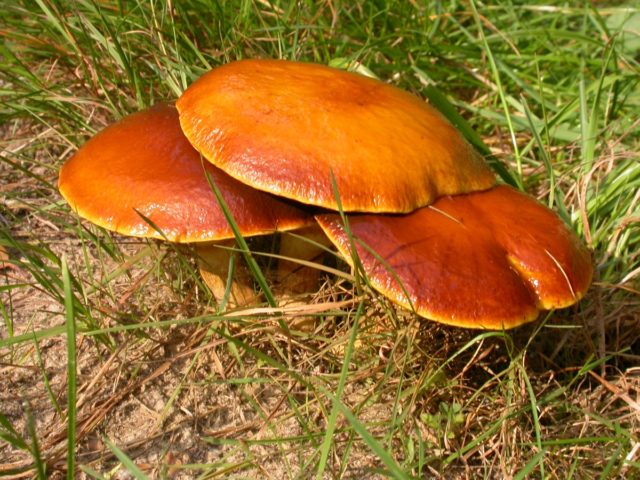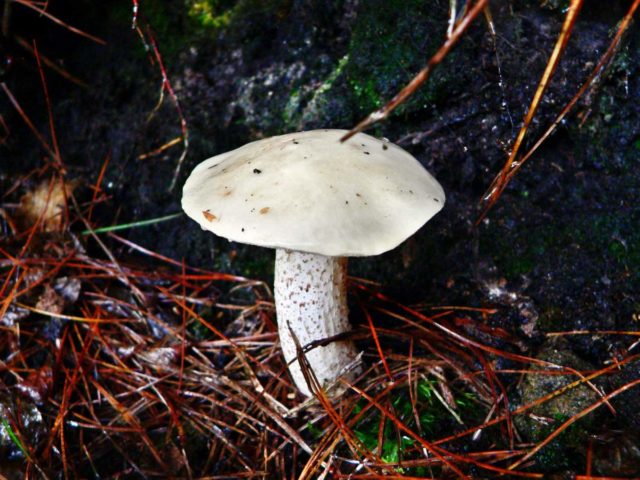Content
Cedar oiler is an edible mushroom. It is difficult even for an inexperienced mushroom picker to confuse it with other species. The name speaks for itself. There are about 40 varieties in total. They are classified as tubular mushrooms of the Maslenaceae family.
What does a cedar oil dish look like?
Butterflies grow predominantly in medium and small sizes. In appearance they often resemble a flywheel. A distinctive feature is the sticky, thin skin that covers the cap. The film may be sticky all the time or only in wet weather. In some varieties it is velvety, and subsequently cracks into small scales.
Description of the cap
The cap has a diameter of 3-15 cm. In young specimens it is spherical in shape. However, over time it straightens, acquiring a pillow-shaped shape.Sometimes, as it grows, a bump appears in the center of the cap.
The surface is fibrous, matte, and seems to be covered with wax. Color orange-brown or yellow. In a humid environment, the cap becomes slimy, but this phenomenon is short-lived.
Description of the leg
The thickness of the stem of the cedar variety is 1-2.5 cm, height - 4-12 cm. The base of the mushroom is thick, but tapers closer to the top. The surface of the leg is covered with small milky drops of liquid, which turn into dark brown inclusions. In appearance in the photo, the leg of the cedar butterdish resembles a boletus.
The color of the pulp is light yellow or yellow-orange. Slightly sour taste. The cedar butterdish releases an almond-floral aroma. The tubes are olive or brown in color. Spore powder is dirty yellow in color.
Is cedar butternut edible or not?
Cedar oil mushrooms are edible mushrooms of the second category. They are delicious marinated and also good fried.
However, mushrooms age quickly. A week after growth, the flesh becomes flabby, dark, and is affected by worms.
Where and how does cedar butterfly grow?
Edible mushrooms begin to appear in late May or early June, when the weather is warm. They cannot stand the cold; a comfortable temperature for them is + 17 °C. In addition to heat, plants need moisture. 2-3 days after rain, mushrooms appear on the surface. Fruiting continues until October.
Cedar boletus is common in the Far East and Siberia. Found in cedar, oak-cedar, and pine forests. These mushrooms prefer dry forests and new plantings with small coniferous shoots. Abundant growth is observed on the southern slopes of forests. They grow in groups or singly.
Edible counterparts of the cedar buttercup and their differences
In the forests there are many lookalikes of the cedar butterfly.
- Ordinary oiler. The color of the cap ranges from chocolate to gray. Diameter 4-15 cm. The shape resembles hemispheres, the edges are sometimes raised. The skin is sticky and covered with mucus. Separates well. The leg is a lighter tone. Height 3-12 cm. Cylindrical shape. The pores are small, yellow, round. This variety grows in Europe and Mexico. Fruiting in September-October. The mushroom prefers sandy soils in deciduous and pine forests. Often found in open clearings, sunny meadows, less often in mountainous areas.
- ANDyellow-brown oil can. The color of the cap is brown, brown, olive. Diameter 4-12 cm. The cap of young mushrooms is semicircular, while older ones are flat. The peel comes off in parts. The leg is orange, lemon. They begin to appear in July. They love sandy, dry soil of mixed forests. As a rule, they are adjacent to pine trees.
- Larch oiler. In young specimens the cap is convex and flattens out over time. The surface of the mushroom is sticky to the touch. There are no visible cracks or bumps. The color of the cap is yellow, brown. The leg is thick, solid. The film doesn't come off well. The pulp is fibrous and changes color when exposed to air. Grows almost all over Russia.
- The oiler is white. Young mushrooms have a convex, white cap. Over time, the shape becomes concave and the color gray-white. They grow near pine trees. They are consumed pickled, fried, and salted. It is preferable to collect young mushrooms.
- Red oiler. Small mushroom. Found in mixed forests. It has a mild taste and pleasant aroma.This specimen lives under a larch tree. There it forms a mycelium. It's hard not to notice the red cap. Grows in groups. Collection period July-November.
How to prepare cedar butter
Mushrooms are consumed fried, boiled, or baked. Vegetables go well with them. For the winter, mushrooms can be dried, frozen, or canned. The drying process is somewhat inconvenient. As a result, the fruit becomes thin and fragile. Losing its shape. The dried mushroom can be crushed and used for cooking mushroom powder, which does not lose its beneficial properties.
Cooking time for fresh forest products is 15-20 minutes. Pre-clean the caps from sticky film. Then rinse thoroughly under running water. When cooked, the pulp does not change color.
Conclusions
Cedar butterdish is a tasty, healthy and nutritious mushroom. They grow mainly in deciduous forests, under cedar trees. Only during the collection process it is necessary to inspect them extremely carefully so as not to bring home poisonous specimens.

















